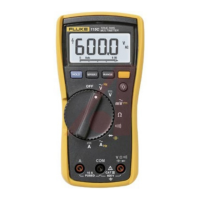Safety Information
3
Safety Information
WWarnings and Precautions
To avoid possible electric shock or personal injury, follow these guidelines:
•
Use the Meter only as specified in this manual or the protection provided by the Meter might
be impaired.
•
Do not use the Meter or test leads if they appear damaged, or if the Meter is not operating
properly.
•
Always use proper terminals, switch position, and range for measurements.
•
Verify the Meter’s operation by measuring a known voltage. If in doubt, have the Meter
serviced.
•
Do not apply more than the rated voltage, as marked on the Meter, between terminals or
between any terminal and earth ground.
•
Use caution with voltages above 30 V ac rms, 42 V ac peak, or 60 V dc. These voltages pose a
shock hazard.
•
To avoid false readings that can lead to electric shock and injury, replace the battery as soon
as the low battery indicator (
N) appears.
•
Disconnect circuit power and discharge all high-voltage capacitors before testing resistance,
continuity, diodes, or capacitance.
•
Do not use the Meter around explosive gas or vapor.
•
When using test leads or probes, keep your fingers behind the finger guards.
• Remove test leads from the Meter before opening the battery door or the Meter case.
International Symbols
The following international symbols appear in this document and on the Meter.
AC (Alternating Current)
Earth ground
DC (Direct Current)
Conforms to European Union directives
AC or DC
Canadian Standards Association
Fuse Double insulated
Important Information. Refer to the
manual.
LISTED
950 Z
Underwriters Laboratories, Inc.
Battery (Low battery when shown on the
display)
N10140
Conforms to relevant Australian standards
Inspected and licensed by TÜV Product Services

